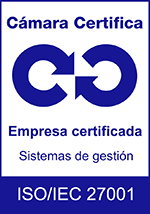To prevent accidents as frequent as those involving the eyes, it is essential to take a predictive approach to planning.
Translated by Laragon. Author: Corey Berghoefer.
Despite their small size, our eyes are pretty big targets when it comes to workplace injuries. Every day 2,000 workers suffer eye injuries in the United States, resulting in about 27,000 days of sick leave. When medical bills and compensation costs are taken into account, in addition to all this downtime, eye injuries end up costing employees around 300 million euros a year.
Taking into account these staggering numbers, it’s clear that many organizations could benefit from improving your approach to eye safety. And there is no better time to start than the present!
However, for For any kind of real change to take root, you have to start at the top. Here, we will describe the correct way to plan for eye safety and by which is up to the employers to implement. Both health and wellness and their results are at stake.
DEVELOP A PREDICTIVE PLAN TO PROMOTE EYE SAFETY
The good news is that 90% of all eye injuries can be prevented, but the leaders of the should make eye safety a priority to keep eye injuries at bay. incidents. Too many organizations take a reactive approach to security. When accidents occur, they come in and clean them up quickly, attend to those who have injured workers and find replacement personnel without missing a beat. But no matter how refined this reactionary response may be, it will not avoid that such incidents may occur again in the future.
WOULD YOU LIKE TO RECEIVE MORE NEWS AND ANALYSIS FROM EHS?
The leaders of the The best security programs are well aware of this difference. Saben that ensuring the safety of employees is not a question of applying to wound dressings, the aim is to identify the factors that lead to the first and remove them from the workplace, with the effect that they can be immediately.
That’s what a predictive security plan can help to take into account. By keeping in contact with the behaviors and work practices that create an environment that is safe working environment, as well as by examining past data for help predict future accidents, safety managers can help predict future accidents. establish controls in all workplaces to address the factors that may affect the of risk. For accidents as frequent as those involving the eyes, it is essential to adopt a predictive approach to planning; simply reacting is not the best way to plan. is sufficient to significantly reduce its incident rate.
WHAT TO INCORPORATE IN YOUR PREDICTIVE PLAN
Manufacturing and construction are two of the three sectors that account for 61% of all the eye injuries in the workplace, so it is imperative to keep the eye safe work practices above other priorities. An analysis The effective identification of potential eye hazards will consider methods of prevention, such as engineering controls, which increase the reliability of the protection while reducing risk and severity. This is recommended for new positions or processes, when new risks or changes occur, or at least twice a year (aligned with the general planning of the security). Highest risk locations with the highest exposure levels to the risk of eye-related injuries may require more frequent eye examinations. frequent.
Before starting to develop a predictive plan, you should familiarize yourself with the risk factors that are unique to your work environment to know how to proceed. At manufacturing and construction activities, suspended particulate matter tends to be more to be the most common cause of eye injuries in the workplace; for Therefore, addressing this in your plan will go a long way toward reducing the ocular incidents.
Workers whose jobs involve hammering, drilling, welding or grinding are especially at risk, as these activities cause sparks, dust and other sharp fragments to become airborne. Even such seemingly innocuous actions as spraying and sanding can put workers at risk of eye injury, so plan to apply proper eye protection at all times.
CHOOSING THE RIGHT EYE PROTECTION
Not all protective equipment is the same. While protective eyewear is sufficient when working with hazardous chemicals, tasks such as welding will require a cap with side shielding and face shield to prevent sparks. There are standards to follow regarding eye safety, such as what is considered proper eyewear and where to place your eyewash stations, consulting these standards can help you develop a comprehensive eye safety strategy. A true and complete predictive plan must take into account the individual needs of your staff and each job.
Talk to employees to learn more about their eye protection habits. If you do not wear proper protective equipment at all times you should know why: Is it uncomfortable or does it make the task more difficult?
The investigation, under certain circumstances, could discover, for example, that certain workers do not wear their safety glasses because they tend to fog up easily. To ensure that hazardous conditions are avoided, it may be recommended to apply an anti-fogging solution to the safety glasses to remedy the situation.
If you ensure proper compliance with regulatory standards at all times and give yourself room to make adjustments based on the needs of your staff, you will have a solid plan in place that is capable of generating effective change.
KEEPING AN EYE ON EYE SAFETY: FROM LEADERSHIP IN ADELANTE
In addition to being the health and safety, to neglect the health and safety eye safety can also have a major impact on your bottom line. How many the more ocular incidents occur, the more employees will fear that their work environment will be work is not safe enough to ensure your safety. It does not It goes without saying that this generates a great harm to morale and its close cousin, commitment.
It is estimated that the organizations with high levels of employee engagement are 17% more engaged than their peers. productive, more profitable and much less prone to turnover. But what more importantly, these companies have a 70% lower incident rate than their competitors. companies where the commitment was low. Taking into account the costly it is to replace an existing employee (up to almost twenty-one times his or her annual salary according to some estimates), neglect their operations of security for too long can wreak havoc on your ability to maintain production and achieve maximum efficiency.
With so many parts involved in day-to-day operations and with risks to the environment. Seemingly in every corner of the workplace, there is much to be done to explain. This is why a centralized security strategy that begins with a leadership from the top and extends to all employees is the most effective way to effective way to reinforce the security of your equipment.
When Management establishes and communicates a clear vision, the more likely it is that the members of the team follow their example. If you have not already done so, start arranging meetings employees to ensure that the care and attention of the employees are caution be the most important thing for your team throughout the year. In addition, communicate your eye safety initiative to middle management in the following areas all the teams and ask them to disseminate it, and more importantly, to make fulfill the message. With the responsibility shared among the leaders of the equipment, the best eye safety practices have a greater likelihood of to be permanently adopted.
ALL EYE-WELLNESS PRACTICES TO FOLLOW
In addition to protecting your eyes from overt hazards in the workplace, be sure to communicate to your team the importance of paying daily attention to your eyes to reduce strain and keep your eyes sharp, both on and off the job. While most of a worker’s tasks probably do not involve spending eight hours at a time looking at screens, computers and smartphones are part of everyone’s daily life; therefore, it is advisable to limit screen time whenever possible. When in front of a screen, avoid sitting in the dark. Excessive brightness of the TV or monitor is harmful to the eyes and can cause strain. Keep your eyes fresh by blinking frequently and taking regular eye breaks.
For a more focused approach structured, try the 20-20-20 rule, which dictates looking at something from 20 feet (7 meters) of distance for at least 20 seconds after every 20 minutes of uninterrupted screen time.
With these suggestions in mind, along with a comprehensive workplace safety program based on sound predictive planning, you’ll be well on your way to reducing eye injuries in your workplace.
For employers who are concerned about the health and safety of their staff, as well as the results of their preventive plans, eye safety is an objective worth considering.
About the author of this publication: Corey Berghoefer is senior vice president of risk management and insurance at staffing firm Randstad in the United States.
Laragon offers the best technological solutions to pilot these processes, working with global market leaders in EHS and Operational Risk Management.
If you would like to know more about our experiences with clients in this area, please contact us by calling us at: +34912547019 or by email: [email protected].




